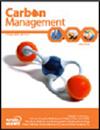Impact of short-term land-use change on soil organic carbon dynamics in transitional agro-ecosystems: a case study in the Brazilian Cerrado
IF 3.2
4区 环境科学与生态学
Q3 ENVIRONMENTAL SCIENCES
引用次数: 1
Abstract
Abstract Agricultural expansion directly impacts the dynamics of organic carbon (C) in the soil. After land use change, agricultural systems with greater resilience of soil C stocks could be preferentially adopted. The objective of the present study was to determine the impact of short-term conversion of grassland into different agricultural systems on soil organic C stocks and their resilience in a site-specific region of Brazilian Cerrado in the State of Goiás. The following systems were evaluated: pasture (PAST), no-tillage system (NT), four organic production systems (ORG) at different years of cultivation (2, 6, 8 and 10 years), and a continuous monoculture corn cropping system (CC). An area of native Cerrado (‘Savanna’, CE) was selected and sampled for use as a steady state reference point. Resilience of soil organic C was measured based on calculation of the C resilience index and C management index. Soil C stocks in the 0-0.40 m depth varied from 61 to 111 Mg ha−1 and were reduced by 33% when converting from CE to cultivation regardless of management system. The labile C contents varied from 425 to 900 mg kg−1, and increased when PAST soils were converted to ORG cultivation. The highest values of C resilience and management indexes occurred in the ORG-2 and ORG-6 soils, showing that organic systems can recover organic C levels in the soil faster than other agricultural systems. On the other hand, no-tillage system when converted from pasture presents the lowest potential of soil C resilience in short-term in the site-specific conditions of studied Cerrado of Goiás State.短期土地利用变化对过渡农业生态系统土壤有机碳动态的影响:以巴西塞拉多为例
农业扩张直接影响土壤有机碳(C)动态。土地利用变化后,可优先采用土壤碳储量弹性较大的农业系统。本研究的目的是确定在Goiás巴西塞拉多州的特定地点,草地短期转化为不同的农业系统对土壤有机碳储量及其恢复力的影响。对不同种植年限(2年、6年、8年和10年)的4种有机生产制度(ORG)和单作玉米连作制度(CC)进行了评价。塞拉多原生地区(“稀树草原”,CE)被选中并取样作为稳定状态参考点。在计算土壤有机碳恢复指数和碳管理指数的基础上,测定了土壤有机碳的恢复能力。0-0.40 m深度的土壤碳储量变化在61 ~ 111 Mg ha - 1之间,无论管理制度如何,从土壤碳转化为耕作的土壤碳储量都减少了33%。活性碳含量在425 ~ 900 mg kg - 1之间变化,在过去土壤转为有机栽培后,活性碳含量增加。土壤C恢复力和管理指标均以ORG-2和ORG-6土壤最高,说明有机系统比其他农业系统能更快地恢复土壤中的有机C水平。另一方面,在Goiás州塞拉多研究的立地特定条件下,免耕制度由牧场转化为土壤C的短期恢复潜力最低。
本文章由计算机程序翻译,如有差异,请以英文原文为准。
求助全文
约1分钟内获得全文
求助全文
来源期刊

Carbon Management
ENVIRONMENTAL SCIENCES-
CiteScore
5.80
自引率
3.20%
发文量
35
期刊介绍:
Carbon Management is a scholarly peer-reviewed forum for insights from the diverse array of disciplines that enhance our understanding of carbon dioxide and other GHG interactions – from biology, ecology, chemistry and engineering to law, policy, economics and sociology.
The core aim of Carbon Management is it to examine the options and mechanisms for mitigating the causes and impacts of climate change, which includes mechanisms for reducing emissions and enhancing the removal of GHGs from the atmosphere, as well as metrics used to measure performance of options and mechanisms resulting from international treaties, domestic policies, local regulations, environmental markets, technologies, industrial efforts and consumer choices.
One key aim of the journal is to catalyse intellectual debate in an inclusive and scientific manner on the practical work of policy implementation related to the long-term effort of managing our global GHG emissions and impacts. Decisions made in the near future will have profound impacts on the global climate and biosphere. Carbon Management delivers research findings in an accessible format to inform decisions in the fields of research, education, management and environmental policy.
 求助内容:
求助内容: 应助结果提醒方式:
应助结果提醒方式:


